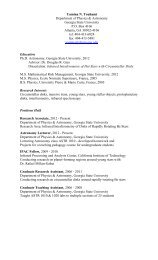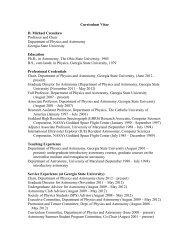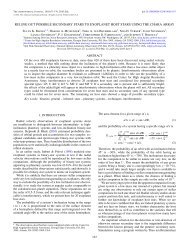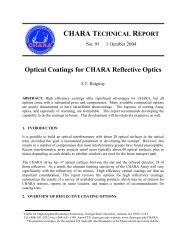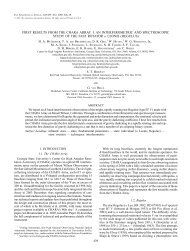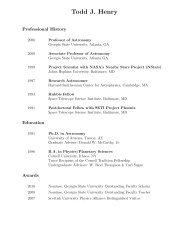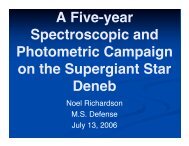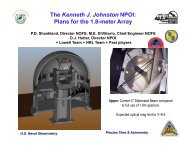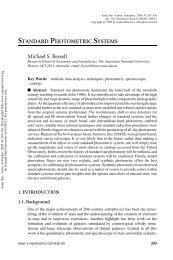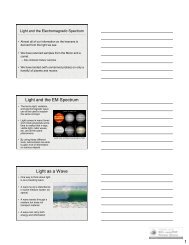the solar neighborhood. ix. hubble space telescope detections of ...
the solar neighborhood. ix. hubble space telescope detections of ...
the solar neighborhood. ix. hubble space telescope detections of ...
You also want an ePaper? Increase the reach of your titles
YUMPU automatically turns print PDFs into web optimized ePapers that Google loves.
1734<br />
GOLIMOWSKI ET AL.<br />
(RECONS) 8 —we report <strong>the</strong> discoveries <strong>of</strong> VLM companions<br />
to three nearby M and L dwarfs (G239-25, GJ 1001B, and<br />
LHS 224), and we confirm companions to two o<strong>the</strong>r M dwarfs<br />
(GJ 54 and GJ 84). All but one <strong>of</strong> <strong>the</strong>se binary dwarfs have<br />
projected separations less than 5 AU. We discuss <strong>the</strong> potential<br />
impact <strong>of</strong> <strong>the</strong>se companions on <strong>the</strong> MLR, and we update <strong>the</strong><br />
state <strong>of</strong> multiplicity among presently known members <strong>of</strong><br />
<strong>the</strong> RECONS ‘‘10 pc sample.’’<br />
2. OBSERVATIONS AND DATA PROCESSING<br />
Table 1 contains basic information about <strong>the</strong> five M and L<br />
dwarfs to which we report newly discovered or confirmed<br />
VLM companions. Information about GJ 1001A (also known<br />
as LHS 102A) is also included to provide a full description <strong>of</strong><br />
<strong>the</strong> GJ 1001 system. Table 2 is a log <strong>of</strong> initial and follow-up<br />
observations <strong>of</strong> each dwarf conducted with NICMOS, <strong>the</strong> HST<br />
Advanced Camera for Surveys (ACS) and Fine Guidance<br />
Sensor 1r (FGS1r), and <strong>the</strong> Astrophysical Research Consortium<br />
(ARC) 3.5 m <strong>telescope</strong> at Apache Point Observatory<br />
(APO). We now describe <strong>the</strong>se observations in detail.<br />
2.1. NICMOS Observvations<br />
Each dwarf was observed at a single epoch with NICMOS<br />
Camera 2 (NIC2), which has a p<strong>ix</strong>el scale <strong>of</strong> 0B076 and a field<br />
<strong>of</strong>view(FOV)<strong>of</strong>19B5 ; 19B5 (Roye et al. 2003). The dwarfs<br />
were acquired as close to <strong>the</strong> center <strong>of</strong> <strong>the</strong> NIC2 field as <strong>the</strong><br />
uncertainties in <strong>the</strong>ir coordinates and proper motions allowed.<br />
Images were recorded in fine-guidance mode through <strong>the</strong><br />
F110W, F180M, F207M, and F222M filters (Table 3), which<br />
alternately sample <strong>the</strong> 1–2.5 m spectra <strong>of</strong> putative brown<br />
dwarf companions outside and inside <strong>the</strong> CH 4 absorption<br />
bands at 1.6–1.8 and 2.2–2.4 m. Figures 1a and 1b show<br />
that this combination <strong>of</strong> filters permits easy discrimination <strong>of</strong><br />
late M, L, and T dwarfs from most background stars. We use<br />
this color discrimination and expectations based on Galactic<br />
latitude to identify candidate VLM companions among <strong>the</strong><br />
many faint sources <strong>of</strong>ten imaged in a target field.<br />
Images through each filter were recorded using NICMOS’s<br />
multiple-accumulate (MULTIACCUM) mode, which allows<br />
<strong>the</strong> detector to be read nondestructively in predefined sampling<br />
sequences. Two sets <strong>of</strong> exposures totalling 64 s were<br />
recorded through each <strong>of</strong> <strong>the</strong> F110W and F180M filters, and<br />
two sets <strong>of</strong> exposures totalling 128 s were recorded through<br />
each <strong>of</strong> <strong>the</strong> F207M and F222M filters. All sets <strong>of</strong> exposures<br />
were recorded using a logarithmic sampling sequence that<br />
provides large dynamic range among <strong>the</strong> constituent images.<br />
The images were reduced using <strong>the</strong> standard NICMOS calibration<br />
s<strong>of</strong>tware (Dickinson et al. 2002) and appropriate reference<br />
images and tables. The calibration s<strong>of</strong>tware combines<br />
<strong>the</strong> constituent images <strong>of</strong> each sampling sequence so that<br />
values <strong>of</strong> p<strong>ix</strong>els ultimately affected by cosmic-ray impacts or<br />
saturation are replaced by appropriately scaled values <strong>of</strong> those<br />
p<strong>ix</strong>els sampled before <strong>the</strong> contaminating event. Consequently,<br />
<strong>the</strong> lost data in <strong>the</strong> reduced images are limited to intrinsically<br />
bad p<strong>ix</strong>els and/or p<strong>ix</strong>els that were saturated before <strong>the</strong> first<br />
nondestructive read <strong>of</strong> <strong>the</strong> detector (i.e., within <strong>the</strong> first 0.303 s<br />
<strong>of</strong> <strong>the</strong> exposure). Figure 2 shows <strong>the</strong> set <strong>of</strong> reduced and calibrated<br />
images obtained for a typical target, namely, <strong>the</strong> binary<br />
M dwarf GJ 84AB.<br />
8 Information about RECONS is currently available on <strong>the</strong> World Wide<br />
Web at http://www.chara.gsu.edu/RECONS.<br />
To facilitate <strong>the</strong> detection <strong>of</strong> faint companions in <strong>the</strong> reduced<br />
images, we subtracted <strong>the</strong> point-spread functions<br />
(PSFs) <strong>of</strong> <strong>the</strong> target stars in <strong>the</strong> manner described by Krist<br />
et al. (1998). First, we selected reference PSFs for each target<br />
and filter from <strong>the</strong> large collection <strong>of</strong> single-star images<br />
recorded during our snapshot survey. The reference PSFs for<br />
a given target were those that best matched not only <strong>the</strong><br />
brightness, spectral type, and field position <strong>of</strong> <strong>the</strong> target, but<br />
also <strong>the</strong> location <strong>of</strong> NIC2’s migratory cold mask at <strong>the</strong> time <strong>of</strong><br />
<strong>the</strong> observation. The reference PSFs were <strong>the</strong>n iteratively<br />
shifted, scaled, and subtracted from <strong>the</strong> target images until<br />
<strong>the</strong> residuals were visually minimized. Figure 3 shows <strong>the</strong><br />
results <strong>of</strong> this technique for <strong>the</strong> images <strong>of</strong> GJ 84AB shown in<br />
Figure 2. Our imaging and processing strategies yield sensitivities<br />
to faint companions that are dependent on <strong>the</strong> brightness<br />
<strong>of</strong> <strong>the</strong> target, <strong>the</strong> quality <strong>of</strong> <strong>the</strong> PSF subtraction, and <strong>the</strong><br />
field position. Krist et al. (1998) reported our detection limits<br />
at various angular distances from representative targets whose<br />
PSF-subtracted images are <strong>of</strong> average quality.<br />
We measured <strong>the</strong> apparent magnitudes <strong>of</strong> unsaturated and<br />
well-separated targets and field sources using conventional<br />
aperture photometry. To convert instrumental count rates to<br />
Vega-based magnitudes, we used aperture corrections computed<br />
for our selection <strong>of</strong> NICMOS filters (Krist et al. 1998)<br />
and <strong>the</strong> conversion recipe described in <strong>the</strong> HST Data Handbook<br />
for NICMOS (Dickinson et al. 2002):<br />
m ¼<br />
n<br />
2:5 log PHOTFNU ; CR ; ½F (Vega)Š<br />
1<br />
o<br />
þ ZP(Vega);<br />
ð1Þ<br />
where PHOTFNU is <strong>the</strong> bandpass-averaged flux density for a<br />
source producing a count rate <strong>of</strong> 1 DN s 1 , CR is <strong>the</strong> count<br />
rate (in DN s 1 ) <strong>of</strong> <strong>the</strong> observed source measured for an infinite<br />
aperture, F (Vega) is <strong>the</strong> flux <strong>of</strong> a zero magnitude star<br />
with a Vega-like spectrum, and ZP(Vega) ¼ 0:02 is <strong>the</strong> magnitude<br />
<strong>of</strong> Vega in all NICMOS bandpasses (Campins et al.<br />
1985). Table 3 lists <strong>the</strong> values <strong>of</strong> PHOTFNU and F (Vega)<br />
adopted for images obtained before and after <strong>the</strong> installation<br />
<strong>of</strong> <strong>the</strong> NICMOS Cooling System (NCS) in 2002 March.<br />
We computed <strong>the</strong> magnitudes <strong>of</strong> closely separated point<br />
sources from model NIC2 PSFs that were generated using <strong>the</strong><br />
Tiny Tim s<strong>of</strong>tware package (Krist & Hook 2003) and <strong>the</strong>n<br />
fitted to each overlapping image. 9 To verify <strong>the</strong> fidelity <strong>of</strong> this<br />
method, we compared <strong>the</strong> four-band magnitudes <strong>of</strong> 35–80<br />
single stars obtained from fitted Tiny Tim PSFs with those <strong>of</strong><br />
<strong>the</strong> same stars obtained via conventional aperture photometry.<br />
The fitted F207M and F222M magnitudes were, on average,<br />
indistinguishable from those obtained via aperture measurements.<br />
The fitted F110W and F180M magnitudes, however,<br />
differed from <strong>the</strong> aperture magnitudes by an average <strong>of</strong> +0.013<br />
and 0.022 mag, respectively. We <strong>the</strong>refore corrected <strong>the</strong><br />
F110W and F180M magnitudes <strong>of</strong> closely separated sources<br />
by subtracting <strong>the</strong>se average <strong>of</strong>fsets. The rms deviations between<br />
<strong>the</strong> model and aperture magnitudes <strong>of</strong> our single-star<br />
sample were 0.08 mag for F110W and only 0.03 mag for<br />
<strong>the</strong> o<strong>the</strong>r filters. This consistency encouraged us to estimate<br />
<strong>the</strong> magnitudes <strong>of</strong> overexposed targets using model PSFs<br />
9 We used model PSFs instead <strong>of</strong> natural reference PSFs because Tiny Tim<br />
produces oversampled images that can be more accurately fitted to <strong>the</strong> overlapping<br />
and undersampled NIC2 images. The model PSFs were generated with<br />
5 times <strong>the</strong> p<strong>ix</strong>el resolution <strong>of</strong> NIC2, aligned, and scaled to each imaged source<br />
and <strong>the</strong>n binned to <strong>the</strong> nominal NIC2 resolution to assess <strong>the</strong> quality <strong>of</strong> <strong>the</strong> fit.



